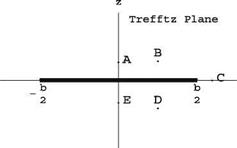Equilibrium of the Aggie Micro Flyer
The AMF has a span bm = 1m and a constant chord cxm = 0.192 m.
14.4.3.1 Main Wing
What is the wing aspect ratio, ARm?
Using the viscous polar of the Selig 1223 at Re = 200,000 with the “prandtline. f” code, it was found that the wing has a lift slope dCLm/da = 4.8701. Compare this result with the theoretical formula dCLm/da = 2n / (1 + 2/ARm).
14.4.3.2 Lift Curves
The linearized lift curve at low incidences for the main wing is: CLm = 4.8701a + 0.6997, and for the tail: CLt = 1.6338a + 3.4529tt – 0.26135, a and tt in radian.
Give the general formula for the lift CL (a, tt) of the combination of the wing and tail of areas Am and At, and reference area Aref = Am + At.
Application: check that with Am = 0.192 m2, At = 0.1525 m2, CL (a, tt) = 3.4374a + 1.5286tt + 0.2742.
14.4.3.3 Moment Curve
The moment coefficient for the complete airplane is given by: CM, o(a, tt) = -1.378a – 1.268tt – 0.03492.
Write the equilibrium equation for the aerodynamic moment (or equivalently write CM, cg = 0), given that xcg/lref = 0.3064. Neglect moment contribution from the engine.
Solve for aeq (tt).
Application: The maximum speed corresponding to full throttle and horizontal flight corresponds to tt = 1.63°. Find the angle of incidence aeq in deg.











 is infinite. A more desirable result is obtained by combining a few modes to improve the lift. Consider the following combination where only the odd modes, which are symmetric in y are used:
is infinite. A more desirable result is obtained by combining a few modes to improve the lift. Consider the following combination where only the odd modes, which are symmetric in y are used: